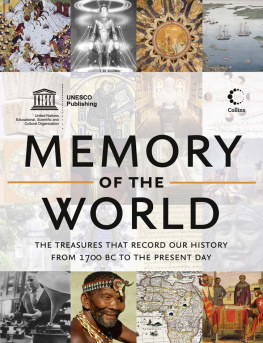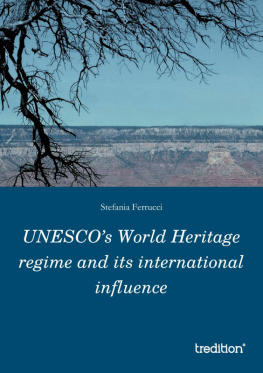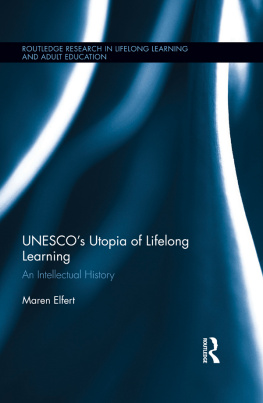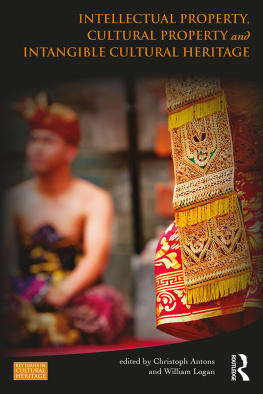
MEMORY OF THE WORLD

Contents
The book is ordered by the date the documents were recorded
by Irina Bokova
Director-General of UNESCO

UNESCO
UNESCO launched the Memory of the World Programme in 1992 to protect and promote the worlds documentary heritage through preservation and access access to encourage protection, and preservation to ensure access.
This vision was vindicated a few months later, when on 25 August 1992, 1.5 million books in the Bosnia National and University Library in Sarajevo were destroyed. With this, a chapter of the history of humanity vanished. Too much of our heritage is lost like this in the heat of conflicts and through the twists and turns of history. Too much also lies hidden and inaccessible in libraries, museums and archives. This documentary heritage carries the memory of human experience. It is a vehicle for identity and a wellspring of knowledge and wisdom. For twenty years, UNESCO has worked to capture and to share this wealth for the benefit of all.
The UNESCO Memory of the World Registry contains today 245 documentary items from all parts of the world from clay tablets, manuscripts and films to photographs, maps and web pages. This Register is our flagship to preserve, raise awareness and promote access to the documentary treasures of humanity. Preserving this heritage is important for maintaining the cultural heritage and identity of all societies. It safeguards our memories as a force shaping us as social beings in a common humanity.
The Memory of the World encourages every country to establish a national register and propose items for the international register. Heritage can be recorded on any of the carriers used to safeguard memories. These range from listings of archives relating to historical figures, such as Nelson Mandela and Alfred Nobel, to major historical events, voyages of exploration that have transformed the world, and the records of scientific discoveries and anthropological recordings. The scope is as vast, indeed, as is human experience.
Anne Franks Diaries or the Epigraphic Archives of Wat Pho need little explanation today. However, other items on the Register, such as the Sakubei Yamamoto collection and the 1824-1897 Royal Archives of Madagascar, may be less well-known but are no less emblematic of human ingenuity.
This book reveals this heritage in all of its diversity. For twenty years, the Memory of the World programme has gone from strength to strength. We must now take it ever further by increasing nominations from all countries and by raising the visibility of preserving sources of knowledge of outstanding significance. Memory of the World is coming of age at a time when preserving our documentary heritage is more important than ever.

Roslyn Russell PhD
Chair, International Advisory Committee
UNESCO Memory of the World Programme
Among the 245 inscriptions on the UNESCO Memory of the World Register is the Tuol Sleng Genocide Museum archives from Cambodia. One photograph in the archives shows a young mother cradling a baby. It is an image that brings to mind countless others of the same subject a mother and child especially images of the Madonna and the Christ Child, the essence of serenity and spiritual grace.
But learning of the fate that met this particular mother and child can evoke an almost unbearable pain in the viewer for these two individuals, after having been meticulously documented in this photograph, were taken out and killed, as were the other subjects of the photographs in the Tuol Sleng Genocide Museum archives . These documents form a historical record, to be sure, but they also deliver a powerful emotional charge and remind us of things that never should be forgotten, or repeated.
World significance, provenance and authenticity, and rarity and uniqueness are key values when assessing the suitability of a nomination of documentary heritage for inscription on the UNESCO Memory of the World Register. However, we must never forget the reasons why documents are so important to us, and why we believe so passionately in their preservation.
The historical evidence that documents convey is one reason; others are the beauty and craftsmanship, or the technical innovations some documents display. The capacity of documents to engage our emotions and connect us to people and events in the past is another.
Archivists, librarians and museum curators who work with collections relating to Indigenous people can testify to the powerful emotions that flow when these people find their families mentioned in documents, or see photographs or film footage of their ancestors, or hear recordings of voices speaking their language.
Holy books and writings can also evoke strong emotional responses in members of particular faith systems. For a believer, a document associated with a saint or a prophet is not just a physical object; it possesses a spiritual power over and above its historical significance, or its value as an original, rare or unique item.
The popularity of exhibitions of documents indicates how compelling these can be in connecting people with the past. An exhibition curator explains why visitors flock to see displays of letters by writers, artists, scientists, philosophers, inventors, and political figures: We see the writers words directly, unfiltered. The manuscripts give a sense of the authors daily lives, friendships, concerns and ambitions, their work and their leisure. Original music manuscripts can have the same emotional power, as the viewer sees the erasures, the corrections and the resolutions that lie behind a finished score. Even the pen strokes can convey the passion and intensity of composition. There are few objects of material culture that are more imbued with the personality of their originators than documents such as these.
It is the task of the UNESCO Memory of the World Programme to ensure that future generations will be able to access these documents and experience their emotional power, as well as to learn about the historical memories that they convey, or appreciate their beauty and craftsmanship.


Albania
Angola
Argentina
Armenia
Australia
Austria
Azerbaijan
Bahamas
Barbados
Belarus
Belgium
Belize
Benin
Bermuda
Bolivia
Brazil
Bulgaria
Cambodia
Canada
Chile
China
Colombia
Croatia
Cuba
Curaao
Czech Republic
Denmark
Dominica
Dominican Republic
Egypt
Estonia
Ethiopia
Finland
Fiji
France
Georgia
Germany
Ghana
Guyana
Hungary
Iceland
India
Indonesia
Iran
Ireland
Italy
Jamaica
Japan
Kazakhstan
Korea (Republic of )
Latvia
Lebanon
Lithuania
Luxembourg
Madagascar
Next page











